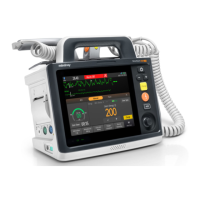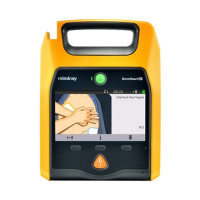8 - 1
8 Noninvasive Pacing
8.1 Pacing Safety Information
• Heart rate and related alarms may be unreliable during pacing, you should always keep the patient
under close survillance. The indicated heart rate or related alarms cannot be used as the sole basis
for the patient’s perfusion status.
• Monitoring ECG alone is sometimes not enough to verify that the patient’s heart is providing cardiac
output. The patient’s response to pacing shall be verified by signs of improved cardiac output, such
as a palpable pulse rate the same as the rate which pace pulses are being delivered, a rise in blood
pressure, or improved skin color.
• To avoid a possible shock hazard, be careful to apply the electrode pads on the patient during
pacing.
• If you are using the pacing function with battery power and the alarm “Low Battery” is presented,
connect the equipment to external power supply or install a fully charged battery.
• Accessing the Pacer mode can be configured as password protected. Make sure you know and
remember the password. Otherwise the pacing therapy cannot be delivered.
• For treatment of the patient with an implanted devices, such as permanent pacemaker or
cardioverter-defibrillator, consult a physician and the instructions for use delivered with the device.
• Prolonged noninvasive pacing may cause patient skin irritation and burns. Periodically inspect the
underlying skin and change ECG electrodes and electrode pads.
• If pacing is interrupted for any reason, you must select Start Pacing to resume pacing.
• In the Pacer mode, you cannot change the patient’s internal paced status from the ECG Setup menu.
• In the case that electrode pads poorly contact the patient, the alarm “Pacer Stopped Abnormally”
and “Pads Off” may be presented.
• Electrode pads are not an available choice for the source of ECG waveform in the Pacer mode.
• In the Pacer mode, arrhythmia analysis is supported and available arrhythmia alarms are asystole,
ventricular vibrillation and ventricular tachycardia.
• The monitoring or pacing function may be unstable in the presence of ESU or other electronic
devices.

